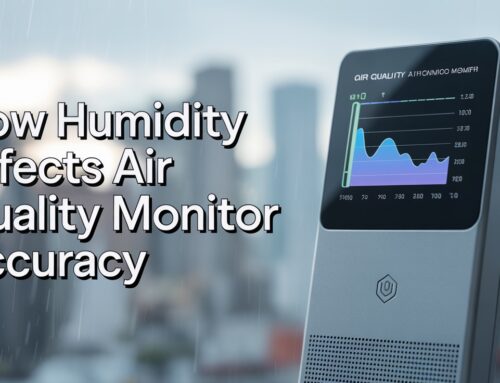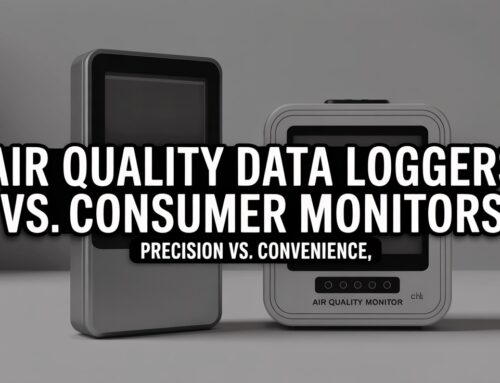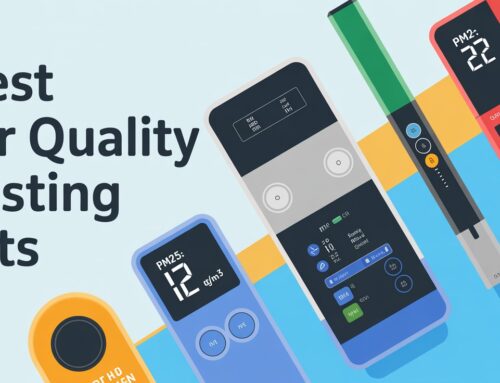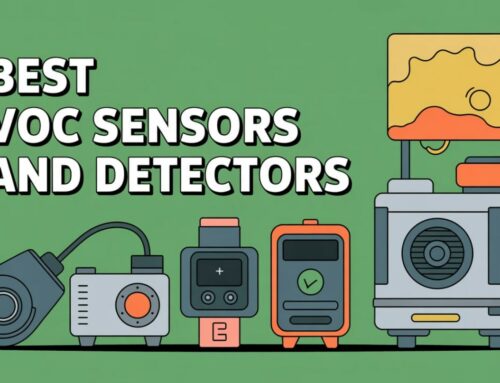August 22, 2025
Portable vs. Stationary Air Quality Monitors
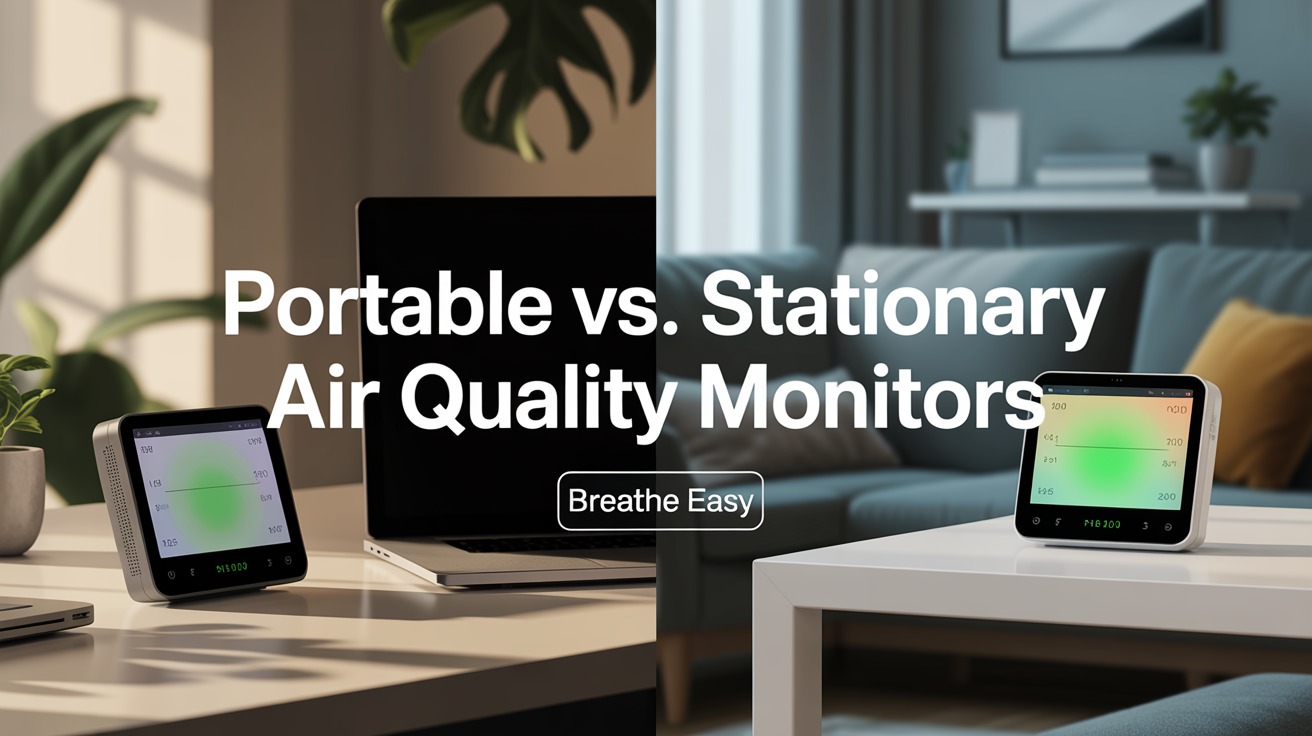
Choosing between portable and stationary air quality monitors affects your health decisions and budget for years to come. This guide explains the key differences to help Canadian homeowners and businesses make the right choice.
What Makes These Monitor Types Different?
Small devices you can carry anywhere. They run on batteries and connect to smartphone apps for real-time monitoring on the go.
- Battery-powered operation
- Smartphone app connectivity
- Room-to-room comparison
- Personal exposure tracking
Fixed-location devices that plug into wall power. They provide consistent data from the same location day after day.
- Continuous power supply
- Long-term data collection
- Higher accuracy sensors
- Automated alert systems
How Accurate Are Portable vs. Stationary Monitors?
Accuracy Levels You Can Expect
Portable monitors typically achieve 70-85% accuracy compared to reference-grade equipment. This accuracy works well for general health awareness and identifying major air quality changes. You can trust these readings to alert you about poor air quality days or help you decide when to use air purifiers.
Stationary monitors often reach 85-95% accuracy when properly calibrated. Higher accuracy comes from better sensors, stable power supply, and protection from environmental factors. For health-sensitive individuals or business compliance needs, this improved accuracy justifies the higher cost.
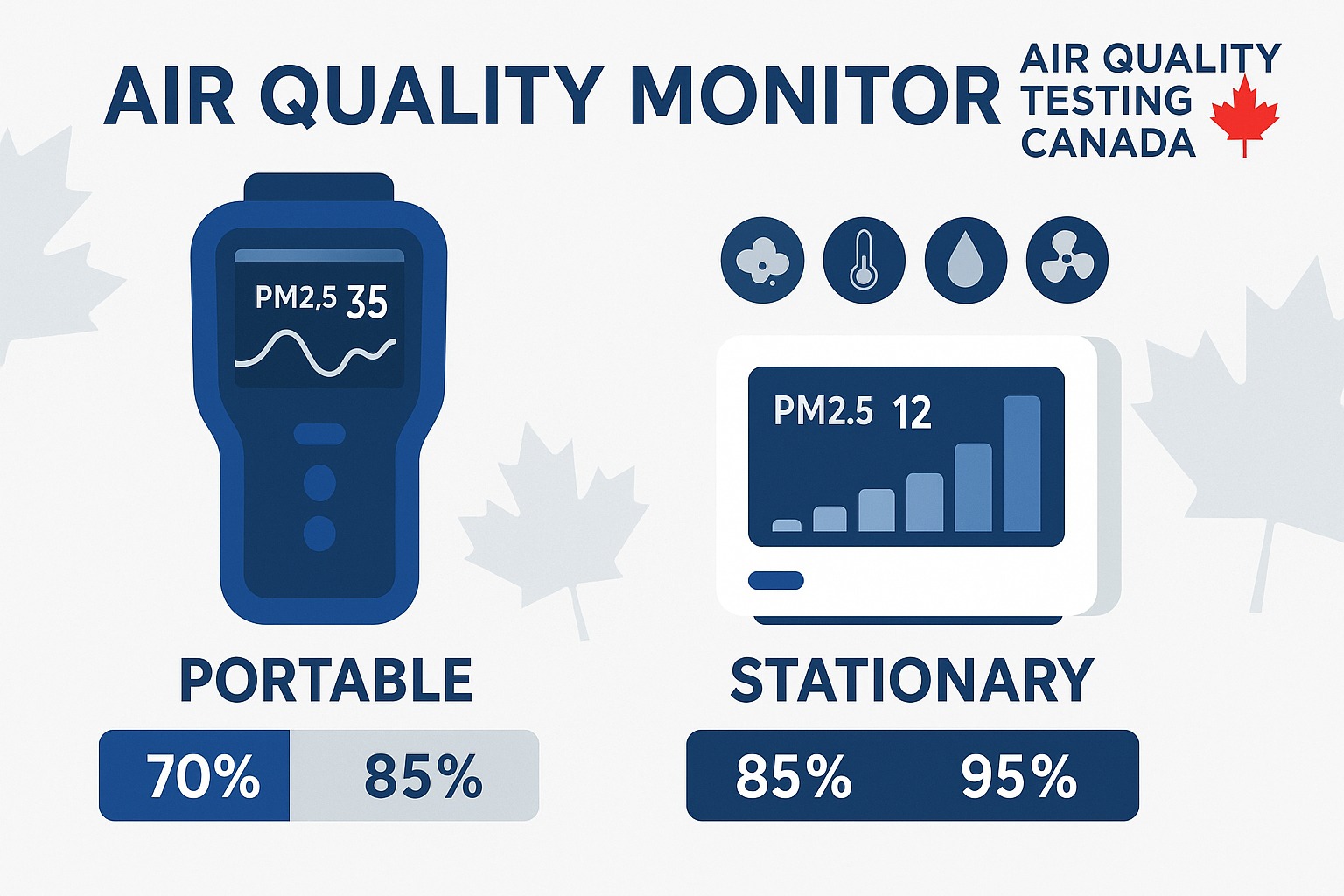
Higher accuracy becomes critical for people with respiratory conditions, elderly residents, or young children who are more sensitive to air pollution. Businesses may need accurate monitoring for employee health or indoor air quality compliance requirements.
Cost Analysis: Upfront Price vs. Long-Term Expenses
Initial Purchase Costs
- Consumer models: $50 – $500
- Professional units: $800 – $3,000
- Includes: Device, accessories, app access
- Home use: $200 – $2,000
- Professional models: $5,000 – $15,000
- Includes: Advanced sensors, integration features
Ongoing Maintenance Expenses
Portable monitors need battery replacements or charging cables over time. Some models require sensor replacements every 1-2 years, costing $50-200 depending on the sensor type. App subscriptions for cloud data storage may add $5-15 monthly.
Stationary monitors often have higher maintenance costs. Professional calibration services cost $200-500 annually. Sensor replacements range from $100-800 depending on sensor type and complexity. However, stationary units typically last longer than portable devices.
Which Monitor Type Fits Your Specific Needs?
Home Environment Applications
✅ Portable Monitors for Homes
- Room-to-room comparison
- Check basement air quality
- Monitor kitchen during cooking
- Decide air purifier placement
✅ Stationary Monitors for Homes
- Main living area monitoring
- Track daily air quality patterns
- Automated health alerts
- Long-term trend analysis
Business and Industrial Uses
Small businesses often start with portable monitors to assess air quality in different work areas. Restaurants can check kitchen air quality, while offices can monitor meeting rooms and work spaces. Portable units help identify problems before investing in permanent monitoring systems.
Larger businesses typically need stationary monitors for consistent employee health protection. Manufacturing facilities, healthcare centers, and schools often install permanent monitoring systems that trigger alerts when air quality drops below safe levels.
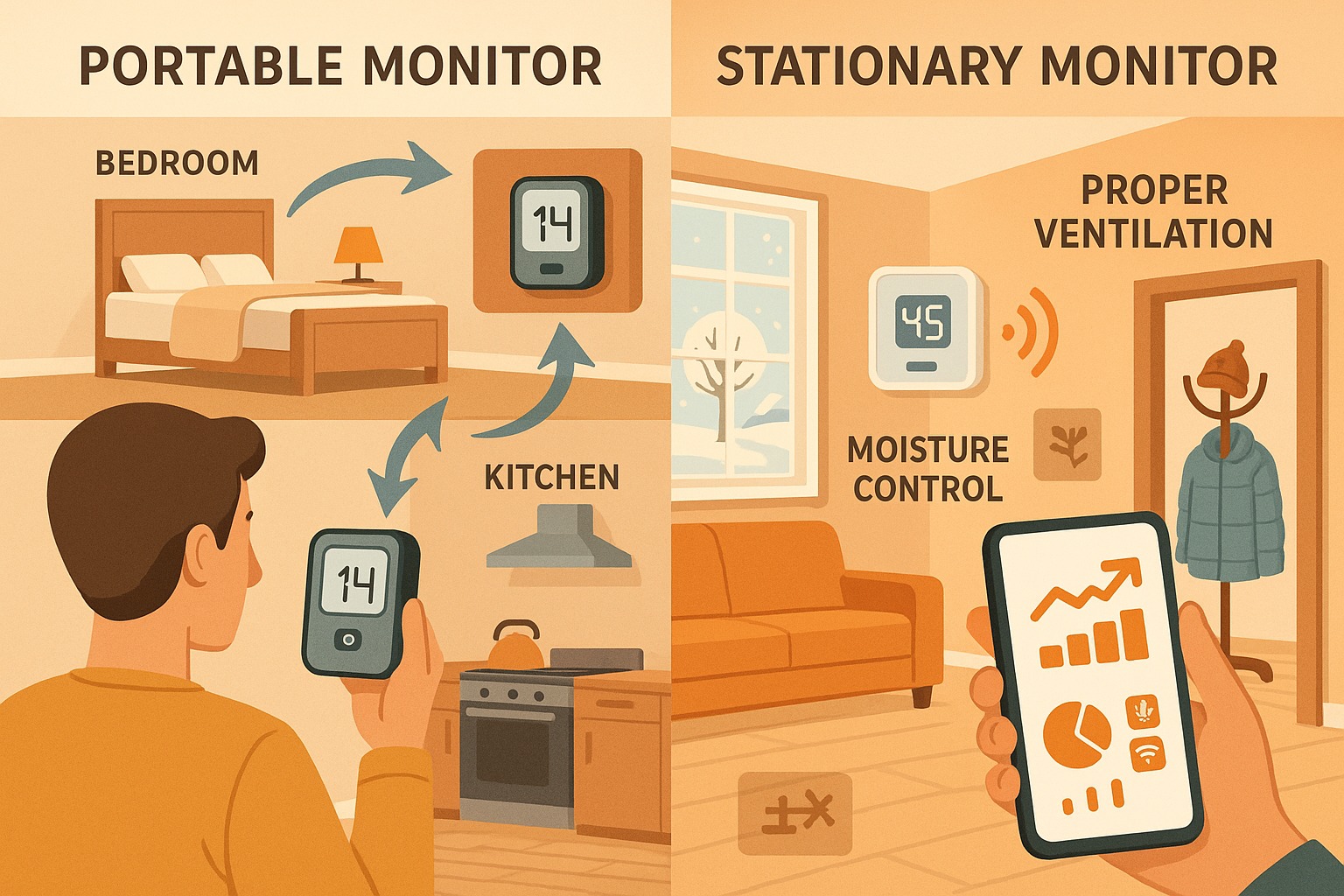
Sensor Types and What Pollutants They Detect
Particle Detection Capabilities
PM2.5 and PM10 sensors appear in most air quality monitors regardless of type. Portable units typically use optical particle counters that shine light through air samples. Stationary monitors may use more sophisticated laser scattering or beta attenuation methods for higher accuracy.
Both monitor types can detect particulate matter from sources like vehicle emissions, wildfire smoke, and indoor dust. However, stationary monitors often provide more detailed size distribution data that helps identify specific pollution sources.
Gas and Chemical Sensors
Portable: Basic MOX sensors for overall VOC levels
Stationary: Specific sensors for formaldehyde, benzene, individual chemicals
Portable: Check CO2 levels throughout home/office
Stationary: Track daily CO2 patterns for HVAC optimization
Ease of Use: Setup, Operation, and Data Access
Initial Setup Requirements
Portable monitors usually require minimal setup beyond downloading a smartphone app and creating an account. Most devices connect via Bluetooth and start measuring air quality within minutes. Battery charging and basic calibration happen automatically.
Stationary monitors may need more complex installation, especially models that integrate with building systems. Professional installation ensures optimal sensor placement and network connectivity. However, many consumer stationary monitors offer plug-and-play operation similar to portable units.
Data Access and Analysis Features
Most modern monitors provide smartphone apps with real-time readings, historical data, and health recommendations. Portable monitors excel at comparing readings from different locations side-by-side. You can easily see how air quality varies between rooms or indoor versus outdoor environments.
Stationary monitors provide detailed trend analysis over weeks and months. This long-term data helps identify seasonal patterns, effectiveness of air quality improvements, and correlation with health symptoms. Some models integrate with smart home systems for automated responses.
Calibration and Maintenance: What to Expect
- Battery management (1-3 years)
- Sensor cleaning (monthly)
- App updates
- Lower overall costs
- Annual calibration ($200-500)
- Environmental protection
- Professional service
- Higher accuracy assurance
Durability and Weather Resistance Considerations
Canadian Climate Considerations
Canadian climate conditions present unique challenges for air quality monitors. Winter temperatures below -20°C can affect battery performance in portable units and sensor accuracy in both types. Summer humidity and temperature swings also impact sensor stability.
Outdoor monitoring applications require weather-resistant housings, protective filters, and temperature compensation features. Stationary monitors designed for outdoor use include heating elements and moisture protection that portable units typically lack.

Most consumer portable monitors are not designed for Canadian winter conditions. Battery life decreases significantly in cold weather, and sensor accuracy may drift. Indoor use is recommended during extreme cold periods.
Regulatory Compliance and Professional Standards
Canadian Air Quality Standards
Health Canada guidelines and provincial regulations establish air quality standards for various environments. Professional air quality monitoring may require specific equipment certifications or calibration procedures to ensure compliance.
Workplace safety regulations often specify monitoring requirements for employee protection. Commercial air quality testing professionals can advise which monitor types meet specific regulatory requirements.
Brand and Model Recommendations by Use Case
Consumer Monitor Options
Comprehensive pollutant detection including PM1, PM2.5, PM10, VOCs, NO2, and weather parameters. 24-hour battery life with smartphone connectivity.
Monitors PM2.5, CO2, VOCs, humidity, temperature, and pressure. Includes radon detection valuable for Canadian homes. WiFi connectivity enables remote monitoring.
Professional Solutions
Research-grade accuracy in portable package. Interchangeable sensor heads, professional calibration support, and data logging capabilities.
High-accuracy particulate matter monitoring for industrial applications. Data logging, alarm functions, and computer connectivity included.
Common Questions About Monitor Selection
Portable monitors typically include factory calibration that lasts 1-2 years. Some models offer field calibration using reference gases, while others require manufacturer service.
Stationary monitors benefit from annual professional calibration, especially in commercial applications. Consumer models may include automatic calibration features that reduce maintenance requirements.
Battery-powered portable monitors are not suitable for permanent installation due to battery replacement requirements. However, some portable monitors include AC power adapters that enable continuous operation.
Purpose-built stationary monitors provide better long-term reliability for permanent installations with automatic calibration, network connectivity, and environmental protection.
Electrochemical sensors typically last 1-3 years depending on exposure levels and environmental conditions. High pollution environments reduce sensor lifespan.
Optical particle sensors can last 5-10 years with proper maintenance. However, LED light sources may degrade over time, affecting accuracy.
Making Your Final Decision: Quick Selection Guide
📱 Choose Portable Monitors If You Need:
- Personal air quality awareness during travel
- Room-to-room comparison in your home
- Temporary monitoring for construction projects
- Budget-conscious air quality awareness
🏢 Choose Stationary Monitors If You Need:
- Continuous monitoring of main living areas
- Business compliance with regulations
- Long-term data for health correlation
- Higher accuracy for sensitive individuals
🔬 Professional Air Quality Testing Services
Sometimes neither portable nor stationary monitors provide the accuracy needed for your situation. Professional testing offers laboratory-grade accuracy using calibrated reference equipment.
Professional testing becomes valuable for real estate transactions, health investigations, or regulatory compliance verification. Air Quality Testing Canada provides certified testing services across Ontario and Quebec with same-day reporting and expert recommendations.
Explore Our Services Call: 1-866-528-2897Expert Recommendation: Contact Air Quality Testing Canada at 1-866-528-2897 to discuss which monitoring approach best fits your specific needs and budget. Our certified technicians can recommend the right combination of professional testing and personal monitoring for your situation.
Related Resources and Further Reading
Mold Testing Services
Professional mold detection and air quality assessment for Canadian homes and businesses.
Why Get IAQ Testing?
Learn about the health benefits and importance of professional indoor air quality testing.
Improve Indoor Air Quality
Practical tips and strategies for maintaining healthy indoor air in Canadian homes.


